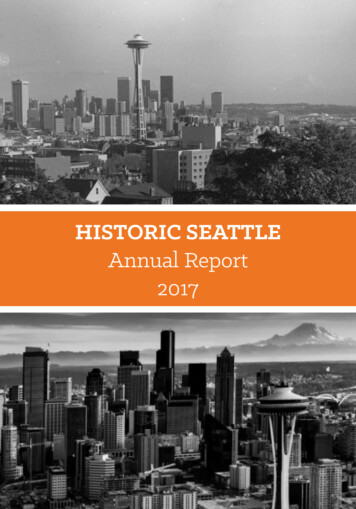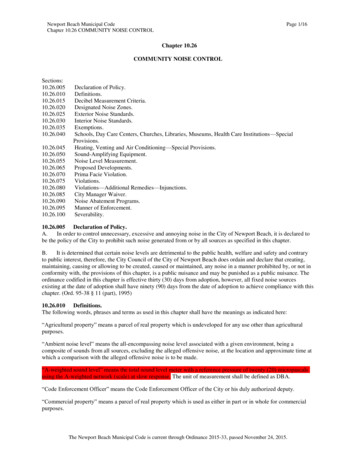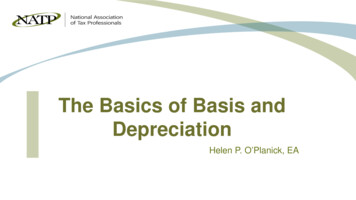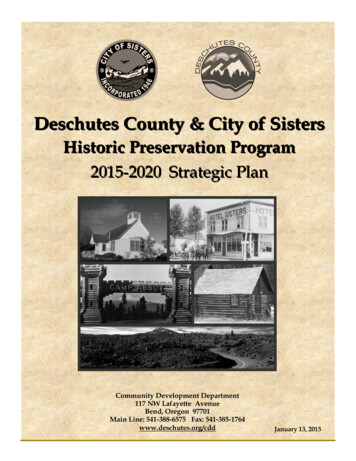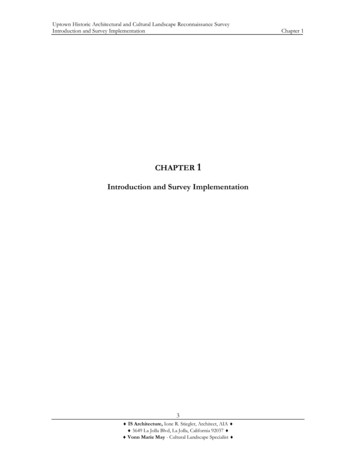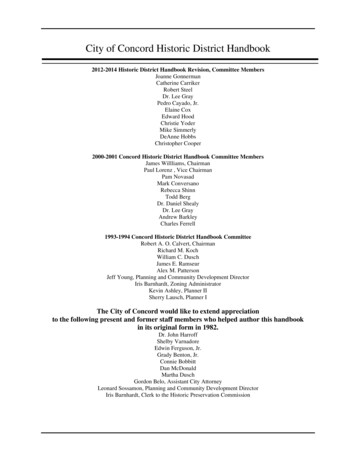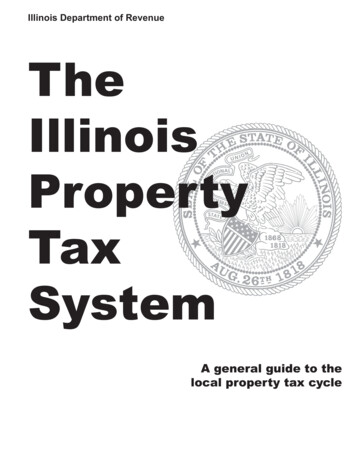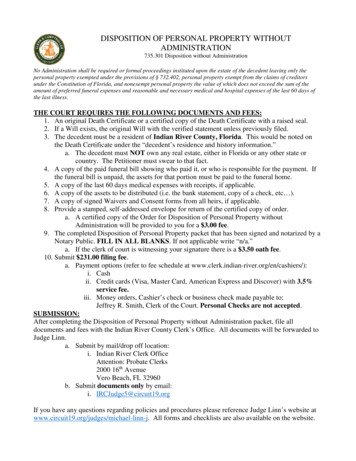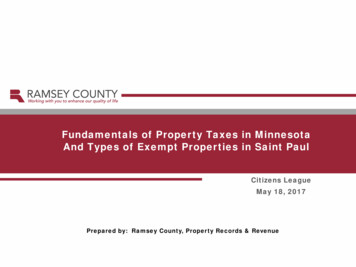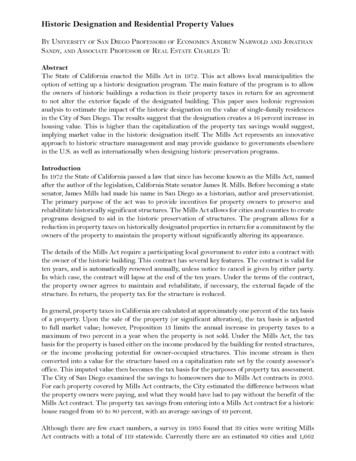
Transcription
Historic Designation and Residential Property ValuesBy University of San Diego Professors of Economics Andrew Narwold and JonathanSandy, and Associate Professor of Real Estate Charles TuAbstractThe State of California enacted the Mills Act in 1972. This act allows local municipalities theoption of setting up a historic designation program. The main feature of the program is to allowthe owners of historic buildings a reduction in their property taxes in return for an agreementto not alter the exterior façade of the designated building. This paper uses hedonic regressionanalysis to estimate the impact of the historic designation on the value of single-family residencesin the City of San Diego. The results suggest that the designation creates a 16 percent increase inhousing value. This is higher than the capitalization of the property tax savings would suggest,implying market value in the historic designation itself. The Mills Act represents an innovativeapproach to historic structure management and may provide guidance to governments elsewherein the U.S. as well as internationally when designing historic preservation programs.IntroductionIn 1972 the State of California passed a law that since has become known as the Mills Act, namedafter the author of the legislation, California State senator James R. Mills. Before becoming a statesenator, James Mills had made his name in San Diego as a historian, author and preservationist.The primary purpose of the act was to provide incentives for property owners to preserve andrehabilitate historically significant structures. The Mills Act allows for cities and counties to createprograms designed to aid in the historic preservation of structures. The program allows for areduction in property taxes on historically designated properties in return for a commitment by theowners of the property to maintain the property without significantly altering its appearance.The details of the Mills Act require a participating local government to enter into a contract withthe owner of the historic building. This contract has several key features. The contract is valid forten years, and is automatically renewed annually, unless notice to cancel is given by either party.In which case, the contract will lapse at the end of the ten years. Under the terms of the contract,the property owner agrees to maintain and rehabilitate, if necessary, the external façade of thestructure. In return, the property tax for the structure is reduced.In general, property taxes in California are calculated at approximately one percent of the tax basisof a property. Upon the sale of the property (or significant alteration), the tax basis is adjustedto full market value; however, Proposition 13 limits the annual increase in property taxes to amaximum of two percent in a year when the property is not sold. Under the Mills Act, the taxbasis for the property is based either on the income produced by the building for rented structures,or the income producing potential for owner-occupied structures. This income stream is thenconverted into a value for the structure based on a capitalization rate set by the county assessor’soffice. This imputed value then becomes the tax basis for the purposes of property tax assessment.The City of San Diego examined the savings to homeowners due to Mills Act contracts in 2005.For each property covered by Mills Act contracts, the City estimated the difference between whatthe property owners were paying, and what they would have had to pay without the benefit of theMills Act contract. The property tax savings from entering into a Mills Act contract for a historichouse ranged from 40 to 80 percent, with an average savings of 49 percent.Although there are few exact numbers, a survey in 1995 found that 39 cities were writing MillsAct contracts with a total of 119 statewide. Currently there are an estimated 89 cities and 1,662
Mills Act contracts statewide according to the California Office of Historic Preservation. Thenumber of contracts provided is the lower bound of the actual number of contracts as there is noenforcement to insure that all contracts are recorded with the State of California. The City of SanDiego has by far the largest number of Mills Act contracts with more than 650 structures covered.The City of Los Angeles is second with around 200 contracts. The City of Anaheim is third withapproximately 125 contracts.The City of San Diego’s experience is probably similar to that of most other cities and countiesoperating under the Mills Act. The City of San Diego did not start writing Mills Act contractsuntil 1995, though the Historical Resources Board has been assigning historic designations since1967. Not surprisingly, the City of San Diego experienced a large upswing in the number of MillsAct contracts in the late 1990’s as housing prices started to soar. As with many cities, the City ofSan Diego has been experiencing financial difficulties since 2002. This has led to a backlog of over100 structures waiting to be evaluated for historic significance.This paper investigates the impact of historic designation on single-family housing values byestimating the price differential between houses covered by Mills Act contracts and those withcomparable attributes but without the designation. The rest of the paper is organized as follows.The next section reviews the literature on historic designation and its effect on property values.The following two sections discuss the methodology and data used in the analysis. Empiricalresults are then presented, followed the conclusion.Literature ReviewCalifornia’s approach to historic preservation through tax benefits to specific properties throughthe Mills Act is very unusual. In other jurisdictions, the typical scenario is for a local historicresources board to identify a geographic area as a historic district. All buildings within that districtthen have the same level of protection, benefits and constraints. The issue then becomes whetherthe creation of a historic district with positive externalities arising from a consistent historic “look”outweigh the costs associated with limitations placed on remodeling and redevelopment of housingstock within the district. The previous literature on the value of historic designation has focusedfor the most part on analyzing this type of historic designation.Asabere et al. (1989) provide one of the first studies of the effect of architecture and historic zoningon housing value. Looking at the town of Newburyport in northeastern Massachusetts, the authorsestimate the impact of both type of architecture and historic zoning district on the value of 520housing units over a three-year period. Using hedonic regression analysis, Asabere et al. identifyeight possible functional forms for housing value. Their results suggest that architectural styledoes have a positive and significant effect on housing values, with buyers willing to pay premiumsfor older homes built in the colonial, federal, garrison and Victorian styles. However, location inthe historic district does not seem to convey any added value to the housing price in and of itself.The results suggest that historic district location is positive and significant in only one of theireight specifications.The effect of historic designation on property values is examined by Ford (1989) using data fromBaltimore, Maryland. The City of Baltimore has approached historic designation by creating historicdistricts. A total of fifteen such districts were created between 1964 and 1985. By examininghousing prices in both 1980 and 1985, Ford tests two major hypotheses. She finds that the pricesof houses in areas that will eventually be designated historic districts are not significantly differentfrom those in non-historic districts. However, her results suggest that houses within designatedhistoric districts do command a premium. Furthermore, Ford tests whether the appreciation in
housing prices were greater the longer the property had been in a historic district. Interestingly,Ford finds no evidence to dispute the hypothesis that the value of historic designation is capitalizedinto the price of the structure upon designation.Coffin (1989) examines the issue of historic district valuation using Aurora and Elgin, Illinois: twowestern suburban cities of Chicago. Coffin’s sample includes 120 sales of homes in Elgin, of which47 are in the historic district, and 243 units in Aurora, 62 of which are in the historic district.Coffin asserts that location in the historic district increases housing price by 6–7%. However,his results are at the extreme edge of typically accepted statistical significance. For Aurora, hemodified his designation of historic significance to identify the historic district homes that arelocated in low-income Census tracts. This surely increased the significance of the historic districtvariable as historic designation in a low-income neighborhood sends an additional signal abouthousing stock quality.Asabere and Huffman (1991) take an innovative approach by examining the effect that historicdesignation has on undeveloped land. Using data from Philadelphia, the authors identify 100transactions involving vacant land sales over the years 1987 to 1989. Their use of Philadelphia asa case study is significant as Philadelphia has limited its ability to designate historic sites solely tospecific structures. Therefore, all historic districts within Philadelphia are federally created. Underthe federal framework, any development of vacant land need only meet local requirements. Thisimplies that there are no additional constraints on development of vacant land in these historicdistricts. Not surprisingly, this lack of constraints leads to a much higher valuation of the land inthese districts. The authors estimate that vacant land for residential purposes is valued 131% higherin historic districts. They also find no significant difference in the valuation of nonresidentialproperties.Asabere and Huffman (1994) extend their work in Philadelphia to estimate the effect of historicdistrict designation to developed residential property. The authors identify a sample of 120 housesthat sold over the period of 1986 to 1990. The authors find that houses sold in federally designatedhistoric districts command a premium of approximately 26%. This benefit is not dependent on anyinvestment tax credits that are typically associated with structures in federally designated historicdistrict.Clark and Herrin (1997) examine the effect of historic preservation districts in the city of Sacramento,California over the years 1990–1994. Sacramento has identified 20 historic preservation districts.Over the study period the authors identify 683 housing sales, of which 58 occurred in 6 of thedistricts. Using hedonic regression analysis, the authors find that houses within the districts sellfor up to 17% more. From this, Clark and Herrin argue that the restrictions placed on housingredevelopment and rehabilitation in these districts are not particularly onerous.Abilene, Texas serves as the case study for Coulson and Leichenko (2001). Abilene is somewhatunusual in that historic designation is conferred on individual properties rather than historicdistricts. The authors use this distinction to estimate the value of historic designation on aparticular property. They find that historic designation has a positive and significant impact onthe value of a property. They estimate that historic designation brings about an increase in housevalue of approximately 17%. The authors attempt to disentangle the tax effects and whether theproperty in listed on a national registry with little success. In addition, the authors provide evidencethat suggests that there is a positive externality associated with historic designation. The resultssuggest that for each additional historically designated house within the census tract, the value ofa house in that census tract increases by 0.14%.
One possible drawback from the majority of the previously cited studies is the reliance on valuinghistoric designation within a particular market. Leichenko et al. (2001) use data from nine Texascities to try to rectify this shortcoming. The cities in their sample follow one of three historicdesignation strategies. Some cities identify individual historic structures, other cities use onlyhistoric districts, and one city uses both approaches. The authors find that the value of historicdesignation increases property values from between 5 and 20 percent. The results were mixedregarding the valuation of national historic designation, state and local designation. In two cities,national historic designation significantly increases property values, while in another city theeffect was not statistically significant.Two studies in Turkey indicate a growing international recognition of the importance of alternativesto state ownership of historically significant structures. Demet and Cengiz (2000) examine theoptions available to preserve and restore parts of the community of Bursa-Cumalikizik, Turkey.The authors recognize that the traditional approach of state directed rehabilitation and preservationis unlikely to succeed without active participation of the population within the district. Likewise,Akansel and Minez (2006) examine the same issues in the Kaleici region of Edirne, Turkey.Although the authors conclude that “funds providing financial support to the owners of thesehouses in the settlement should be set up in order to protect these houses” (p. 10), they do notpropose a system to achieve that goal.MethodologyThis study uses the hedonic price model developed by Rosen (1974) to measure the effect of taxsavings from the Mills Act historic designation on single-family home values. This methodologyis well developed and accepted in real estate and housing economics research. For example, ithas been used to assess the impact of numerous factors on housing values, such as environmentalissues, school quality, and special land uses. In the hedonic model, housing is considered a bundleof attributes, including site, structural, quality, location and market characteristics. The numberand type of attributes embodied in a house distinguish it from other properties and determine itsvalue.Because housing attributes are not traded individually, the value of an attribute can not be directlyobserved. In order to estimate the value of each housing characteristic, multiple regression analysisis utilized. Suppose there are i site and structural attributes, j location characteristics, and k marketfactors in the hedonic model, the semi-log regression equation can be written as:EMBED Equation.3,(1)where P is the sales price of a house, β, λ and μ are coefficients, and ε is an error term. Thecoefficient of an attribute is interpreted as the percentage change in property value given one unitincrease in the attribute. In this study, a dummy variable is used to identify houses that are coveredby Mills Act contracts. The coefficient of this variable represents the effect of historic designationon the value of a house.DataData were collected on sales of single-family detached housing in zip codes 92103 and 92104 inSan Diego, California from January 1, 2000 through December 31, 2006. The two zip codes wereselected for several reasons. They contain some of San Diego’s oldest neighborhoods and thereforehave a relatively large proportion of historically designated homes. In fact, nearly 40% of thestructures that are currently covered by Mills Act contracts in the City of San Diego are locatedin these two zip codes. The housing stock in the neighborhoods has sufficient variation in physical
attributes to allow a meaningful hedonic analysis. Additionally, as these zip codes are contiguous,many of the neighborhood characteristics such as school quality, proximity to downtown andbeaches, and crime rates do not vary greatly.During the seven-year period, 2,045 transactions of single-family residences with valid propertyinformation are retrieved from DataQuick’s PropertyPro CDs. To ensure that the data reflects thehousing market equilibrium and to prevent coding errors and non-arm’s-length transactions fromunduly influencing the analysis, a set of data cleansing criteria are utilized. Approximately 4.5% ofthe observations are excluded, resulting in a final dataset with 1,953 valid observations. Of thesehouses, 25 had received historic designation by the City of San Diego and the owners had signed aMills Act contract. Table 1 presents the descriptive statistics for the dataset, with Panel A showingthe historically designated houses and Panel B the rest of the sample.[Table 1]Somewhat surprisingly, the historically designated houses are not that much older than the otherhouses, with an average age of 68.7, compared to 67.0 for the rest of the sample. Overall, thehistorically designated houses are slightly larger (in terms of square footage, number of bedrooms/bathrooms, and lot size) and sell on average for 263,000 more than those without historicdesignation.Model and ResultsThe hedonic model (Equation 1) is estimated with the dataset to determine the implicit price ofeach housing attribute. In this study, site and structural attributes include the number of bedrooms,the number of bathrooms, the square footage of living area, size of lot, the number of garagespaces, availability of a swimming pool, and the age of the property. To control for neighborhoodeffects within the two zip codes, a set of 24 dummy variables are employed to represent the censustract in which a property is located. As the San Diego housing market experienced remarkableappreciation during the study period, a group of dummy variables that indicate the quarter in whicha transaction occurred is also included to take into account the housing market trend. Additionally,a dummy variable is used to identify houses with historic designation. The value of the variable isone for houses that are covered by Mills Act contracts, and zero otherwise. The coefficient of thisvariable indicates the impact of historic designation on the value of a house, after other housingattributes have been controlled for.Table 2 presents the estimation results of two hedonic models. Model 1 uses the log of sales priceas the dependent variable. The model has a strong explanatory power with an adjusted R2 of83.2%. Most site and structural variables carry the expected sign and are statistically significant.For example, adding 100 square feet of living space increases the housing value by approximately2.7%, and each additional bedroom adds 3.2% value to the house. The coefficient of property age ispositive, suggesting that buyers in this market are willing to pay more for older houses; however,the difference is not statistically insignificant.[Table 2]The variable of interest is the dummy variable for Mills Act historic designation. The variablehas a coefficient of 0.1484 and a t-value of 3.44. This result reveals that historic designation andthe corresponding Mills Act contract increase the value of a single-family home by approximately16.0%.
A number of additional tests are performed to assess the robustness of the empirical results. Thevariance inflation factor (VIF) is used to ensure that the estimation results are not affected bymulticollinearity. Several different model specifications (for example, log and quadratic formsfor property age and lot size) are also considered. The magnitude and significance level of theMills Act variable remains virtually unchanged. Additionally, a linear form regression (wherethe sales price is the dependent variable) is estimated. The coefficient of the Mills Act variableis again positive and highly significant (see Model 2 in Table 2). These tests confirm that withphysical attributes, housing market trends, and neighborhood effects all controlled for, the historicdesignation significantly increases the value of a property.ConclusionThe State of California enacted the Mills Act in 1972. This program provides owners of historicbuildings a reduction in property taxes in return for an agreement to not alter the exterior façadeof the designated building. This paper studies the impact of such historic designation on the valueof single-family homes. Using hedonic regression analysis and housing transactions in San Diegobetween 2000 and 2006, the study estimates the price differential between houses with MillsAct historic designation and comparable houses without the designation. The empirical findingssuggest that the historic designation results in a 16 percent increase in housing value.Theory suggests that the value of any tax benefits should be capitalized into the price of the home.The degree to which this benefit is not fully capitalized represents a cost to the homeowner foragreeing not to alter the building; on the other hand, a price differential exceeding the capitalizedtax benefit implies value in the historic designation itself. In San Diego the tax savings on housesthat are covered by Mills Act contracts range from 40 to 80 percent, with an average of 49 percent.Given a one-percent property tax rate, the price differential identified in the empirical analysis islikely to be higher than the capitalization of property tax savings. Further research with moredetailed data is necessary to investigate the sources of the additional value.The importance of historic preservation has received growing international recognition andmany countries have developed programs to provide tax incentives. Traditional approaches haveconsisted primarily of either public ownership of the structures or the creation of historic districts.California’s approach to historic preservation through the Mills Act provides an alternative model.Communities gain by making sure historically significant structures are preserved while theowners of those structures are compensated with tax savings and higher property values. Thelevel of participation in the Mills Act program indicates that it has been successful in encouragingthe owners of historically significant structures to preserve and maintain their buildings. TheMills Act can therefore serve as a template of how historic preservation may be achieved elsewherein the United States as well as internationally.
ReferencesAkansel, A.S. and B.B. Minez (2006). Planning and Protecting Historical Buildings in Kaleici Region of Edirne, Turkey.Working paper presented at the European Regional Science Association Meetings, Volos, Greece, August 2006.Asabere, P.K., G. Hachey, and S. Grubaugh (1989). Architecture, Historic Zoning, and the Value of Homes, Journal of RealEstate Finance and Economics, 2, 181–195.Asabere, P.K. and F.E. Huffman (1991). Historic Districts and Land Values, Journal of Real Estate Research, 6, 1, 1–7.Asabere, P.K. and F.E. Huffman (1994). Historic Designation and Residential Market Values, Appraisal Journal, 396 – 401.Boyle, M.A. and K.A. Kiel (2001). A Survey of House Price Hedonic Studies of the Impact of Environmental Externalities,Journal of Real Estate Literature 9, 2, 117-144.Carroll, T.M., T.M. Clauretie, and J. Jensen (1996). Living Next to Godliness: Residential Property Values and Churches,Journal of Real Estate Finance and Economics 12, 3, 319-330.Clark, D.E. and W.E. Herrin (1997). Historical Preservation Tax Districts and Home Sales Prices: Evidence from theSacramento Housing Market, Review of Regional Studies, 27, 1, 29–48.Clark, D.E. and W.E. Herrin (2000). The Impact of Public School Attributes on Home Sale Prices in California, Growth andChange 31, 3, 385-407.Coffin, D.A. (1989). The Impact of Historical Districts on Residential Property Values, Eastern Economic Journal, 15, 3,221–228.Colwell, P.F., C.A. Dehring, and N.A. Lash (2000). The Effect of Group Homes on Neighborhood Property Values, LandEconomics 76, 4, 615-637.Coulson, N.E. and R.M. Leichenko (2001) The Internal and External Impact of Historical Designation on Property Values,Journal of Real Estate Finance and Economics, 23, 1, 113–124.Demet, G. and C.R. Cengiz (2000). Preservation and Revitalization of the Historical Settlements: The Case of BursaCumalikizik. Working paper presented at the European Regional Science Association Meetings, Barcelona, Spain, August2000.Ford, A. (1989). The Effect of Historic District Designation on Single-Family Home Prices, AREUEA Journal, 17, 3,353-362.Halvorsen R. and R. Palmquist (1980). The Interpretation of Dummy Variables in Semilogarithmic Equations, AmericanEconomic Review 70, 3, 474-475.Hamilton, B. (1976). Capitalization of Intrajurisdictional Differences in Local Tax Prices, The American Economic Review,66, 5, 743-753.Irwin, E.G. (2002). The Effects of Open Space on Residential Property Values, Land Economics 78, 4, 465-480.Leichenko, R., Coulson, N., and Listokin, D. (2001). Historic Preservation and Residential Property Values: An Analysis ofTexas Cities, Urban Studies, 38, 11, 1973-1987.Mason, R. (2005). Economics and Historic Preservation: A Guide and Review of the Literature, discussion paper, theBrookings Institution Metropolitan Policy Program.Mitchell, D.M. (2000). School Quality and Housing Values, Journal of Economics 26, 1, 53-70.Palmon, O. and Smith, B. (1998). New Evidence on Property Tax Capitalization, Journal of Political Economy, 106, 5,1099-1111.Turnbull, G., Dombrow, J. and Sirmans, C. (2006). Big House, Little House: Relative Size and Value, Real Estate Economics34, 3, 439-456.
BACK
BACK
Contact authorThe actual legislation is contained in the California Revenue and Taxation Code, Article 1.9,Sections 439 – 439.4 and the California Government Code, Article 12, Sections 50280 – 50290.For homeowners who have not moved in many years, the benefits of a Mills Act contractwould not be as significant as to someone who just purchased the same property, due to theprovisions of Proposition 13. This would be especially true during times of high housing priceappreciation. In fact, there is anecdotal evidence of some homeowners with long tenure applyingfor Mills Act contracts as they are preparing to sell their homes.There is an extensive literature on how environmental issues (such as air quality, water qualityand undesirable land uses) on housing values. For a survey of the literature, see Boyle and Kiel(2001).For example, see Mitchell (2000), and Clark and Herrin (2000).For example, Colwell, Dehring and Lash (2000) investigate the impact of group homes onneighborhood property values; Carroll, Clauretie and Jensen (1996) study the effects ofneighborhood churches on residential property values; and Irwin (2002) examines the influenceof open space on residential housing values.Transactions with missing data (such as sales price, lot size, square footage of living area,number of bathrooms, number of bedrooms, and year built) are excluded.An observation is removed if one of the following criteria is met: 1) the year of sale is earlierthan the year built, 2) the lot size is greater than an acre or less than 500 square feet, and 3)the number of bedrooms is greater than 5. The price per square foot (p/sf) is also taken intoaccount to prevent coding errors and exclude non-arm’s-length transactions. The average p/sf in the two zip codes during the study period is 432 with a standard deviation of 134.Observations with p/sf three standard deviations higher ( 834) or lower ( 30) than the averageare also removed.The 25 properties covered by the Mills Act contracts represent 1.28% of the sample, whilehistorically designated single-family houses in the two zip codes (261 properties) represent1.24% of the stock of single-family housing.Due to the large number of variables, parameter estimates of the census tract and quarterdummy variables are not presented in the table, but are available from the authors.For a dummy variable, the percentage effect is equal to (Exp(c)-1), where c is the parameterestimate of the dummy variable (see Halvorsen and Palmquist, 1980).
The City of San Diego examined the savings to homeowners due to Mills Act contracts in 2005. For each property covered by Mills Act contracts, the City estimated the difference between what the property owners were paying, and what they would have had to pay without the benefit of the Mills Act contract.
